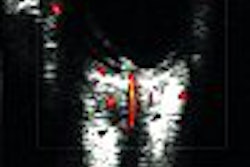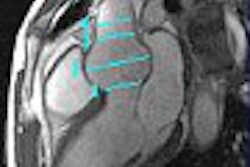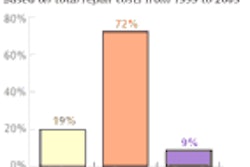While ultrasound screening for abdominal aortic aneurysm (AAA) is gaining support, there is some concern that wider screening and new surgical repair techniques may actually increase perioperative deaths among patients whose aneurysms were not likely to rupture, according to Dr. Christopher Merritt.
"The risk of elective surgery must be balanced against the risk of rupture of an untreated aneurysm, (the risk of) which is directly related to aneurysm size," said Merritt, a, research professor of radiology at Thomas Jefferson University. He discussed the issues surrounding ultrasound screening for AAA during a talk at the 2004 Leading Edge in Diagnostic Ultrasound conference in Atlantic City.
In populations over 60, AAA prevalence is estimated to range between 2%-8%, increasing with age. Few aneurysms less than 4 cm in diameter rupture, however. Overall, 3%-6% of aneurysms greater than 4 cm will rupture annually, with the rupture rate directly related to aneurysm size, Merritt said.
While surgical resection and repair with an artificial graft is an effective AAA treatment, the benefit of detecting asymptomatic aneurysms in older populations, is however, offset by the high prevalence of cardiovascular disease and other causes of morbidity and mortality that add increased risk to elective surgery, Merritt said.
"These factors must be balanced against the risk of rupture of an untreated aneurysm," Merritt said.
Today, most vascular surgeons recommend surgery for asymptomatic aneurysms 5 cm or larger, as the 25%-40% five-year risk of rupture is substantially higher than the risks of surgery, he noted. However, newly developed endovascular treatments are likely to influence the cost/benefit ratio of screening by reducing the cost, hospital stay, debility, morbidity, and mortality of treatment, Merritt said.
Since most AAAs remain asymptomatic until they rupture, diagnostic screening has attracted interest as a means of reducing mortality, he said.
The best screening tool
Palpation and ultrasound are the only approaches to draw interest for mass screening. The accuracy of physical examination for detecting AAA is not known, however, with estimates ranging from 22%-96%, according to Merritt.
Larger aneurysms are easier to detect, though, and detection is easier among thin people, Merritt said. Other imaging methods such as CT and MRI are too expensive, while angiography is too invasive. Radiography comes up short in sensitivity, he said.
Ultrasound, however, is extremely sensitive and specific for AAA of all sizes, with sensitivities ranging from 82%-99%. Visualization of the aorta is inadequate in a small proportion of patients due to obesity, bowel gas, or periaortic disease, Merritt said.
But while ultrasound is the best available test for ultrasound screening, it also suffers from variable accuracy; some studies have indicated measurement errors of up to 5 mm for ultrasound compared with CT, Merritt said.
Ultrasound of the abdominal aorta is relatively simple to perform, but, at least in the U.S., is relatively expensive under the current billing system. Dedicated screening for AAA alone, however, could likely be performed inexpensively with a brief (3-5 minutes) focused exam in a mass screening setting, Merritt said
"Such large-scale programs could significantly alter the cost-benefit ratio in favor of broader screening," he said
MASS trial
Screening for AAA has been examined in several studies, the largest and most recent being the Multicenter Aneurysm Screening Study (MASS). A four-year randomized controlled trial involving 67,800 British men between 65 and 74, the MASS trials aimed to determine if there was any benefit to screening (Lancet, November 16, 2002, Vol. 360:9345, pp. 1531-1539).
In that trial, patients were randomly assigned groups receiving ultrasound or not. Men with abdominal aortic aneurysms 3 cm and larger in diameter were followed up with repeat ultrasound scans for a mean of 4.1 years. Surgery was considered based on specific criteria (diameter of 5.5 cm or larger, expansion of 1 cm or more per year, or symptoms).
A total of 1,333 aneurysms were detected in the 27,147 men screened, and there were 47 fewer deaths in the screening group compared with the control group for an estimated risk reduction of 42%.
In the screened group, 322 had elective operations, compared with 92 in the control group. Thirty-day mortality rates were 6% for both groups.
The screened group received a total of 27 emergency procedures, compared with 54 in the control group. The risk reduction, principally a result of reduced deaths from rupture, was achieved, though, with a small but significant deterioration in health status measures in patients with aneurysms detected at screening, according to the U.K. researchers.
The researchers also examined costs of screening, surveillance, and hospital costs of surgery and drugs. After four years, the cost effectiveness was $55,500 per quality adjusted life year gained. That figure was estimated to fall to $12,300 at 10 years, with 710 subjects would be screened to prevent one death.
"These data indicate that screening a single aortic ultrasound scan at age 65 would be cost effective in the long term," Merritt said
By Erik L. RidleyAuntMinnie.com staff writer
June 18, 2004
Related Reading
Coalition seeks Medicare coverage for aortic aneurysm screening, March 30, 2004
Echogenic liposomes target atherosclerotic plaque for diagnosis, treatment, March 1, 2004
ISET talks offer innovative ways to survey aortic aneurysm repair, January 30, 2004
Quick ultrasound screening for AAA recommended in older men, September 27, 2002
Ultrasound screening of older men reduces aortic aneurysm mortality, July 30, 2002
Copyright © 2004 AuntMinnie.com




















